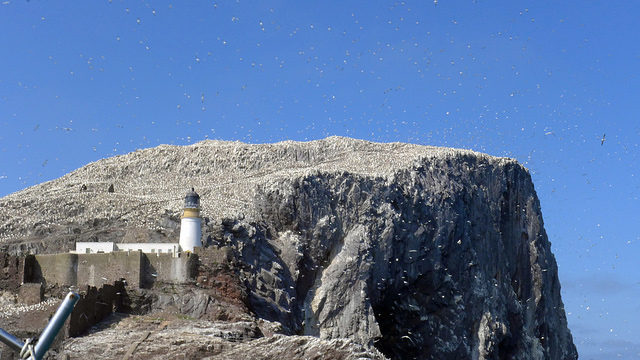Know as The Bass Rock, or by its simplified sobriquet the Bass, this island is located in an area known as the Firth of Forth (or as Myrkvifiörd as authors of the Norse sagas referred to it) and around 3 miles to the east of the town North Berwick in Scotland.
Being a victim of the vicissitude of faith, this island today remains ensnared in its solitude. Throughout the years though some made a home out of it, such as early Christian monks who were after the silence this island offered.

According to oral history, the Scottish saint Baldred of Tyninghame lived on this island in 600 AD. On the spot where a humble hermit cell was once made stand the remains of St. Baldred’s Chapel.

Among the initial owners of this island is the family Lauder of Bass. According to the stories about this rock, the island was a gift from King Malcolm III of Scotland. They were the first to build a castle here. The tombstone of Sir Robert de Lawedre, lairde of Bass, who died in May 1311 can be found in North Berwick.

They castle remained in ownership of the Lauder-Bass family for six centuries. After Sir Robert de Lawedre passed away, the island in part went to his son and the other part was owned by the church until 1316, for this is where Saint Baldred’s chamber was.
In 1406 King Robert III, fearing for the life of his son James, sends him off to the island of Sir Robert Lauder where he could be well protected. Years later and this young Prince James becomes a King and numbers Sir Robert Lauder among the few people he could trust.

Throughout the years the island has been visited by a number of royal guests, among whom was King James IV who visited the island of Bass in 1497. Those who transported the king to the island received 14 shillings for their effort.

Then in 1581, King James VI of Scotland visited the island. Once there he was amazed so at what he saw that he even showed interest in purchasing the island. Besides famous kings, the Bass also had its fair portion of famous prisoners during the 15th century, when it was used as a penal colony.

One, in particular, is Walter Stewart, Earl of Atholl. Even part of the Clan Mackay, a Scottish clan from north of the Scottish Highlands who supported Robert the Bruce in the Scottish Wars of Independence (14th century) were locked here.
After the Commonwealth period (1649-1660) the castle was used as a prison. The current owner of the Bass is Sir Hew Hamilton-Dalrymple, 10th Baronet, whose family purchased the island in 1706.

A latter addition to this island is the Bass Rock Lighthouse which was constructed in 1902. The island itself is a volcanic object born out of hardened magma during the Carboniferous period (299–359 million years ago) and it stands more than 330 feet in height above the North Sea waters.

Carrying evidence from primordial times, this rock was a subject of research for many geologists, including Hugh Miller who wrote about the island in his book Edinburgh and its Neighbourhood, Geological and Historical: with The Geology of the Bass Rock.

Today the island has a human population of zero, but it is home to huge numbers of sea birds, including 150,000 Northern gannets, the largest colony in the world. Even the famous English naturalist Sir David Attenborough made footage of these birds and their unusual way of hunting. They circle in the air searching for fish before they dive head first into the water at a speed of up to 62 miles per hour. Bass rock is a designated nature reserve to preserve this important breeding site, and managed by The Wildlife Trusts of Scotland.
